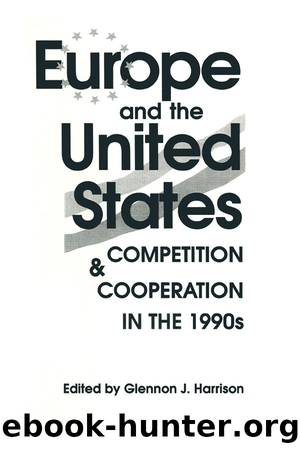Europe and the United States: Competition and Co-Operation in the 1990s: Competition and Co-Operation in the 1990s by Glennon J. Harrison

Author:Glennon J. Harrison [Harrison, Glennon J.]
Language: eng
Format: epub
Tags: Communism; Post-Communism & Socialism, Political Science, General, Political Ideologies
ISBN: 9781315483955
Google: db8YDQAAQBAJ
Goodreads: 32207038
Publisher: Routledge
Published: 1994-02-17T00:00:00+00:00
SUPPORT FOR HIGH-TECHNOLOGY INDUSTRIES
The âforced investmentâ concerns are closely related to EC support for high-technology industries and companies. A number of European industries such as computers, semiconductors, and telecommunications equipment are struggling to compete against stronger Japanese and American companies. In an effort to help European firms compete more vigorously in these areas, the EC has employed trade, procurement, and technology policies to bolster their competitiveness. Given that high-tech exports are the most important and largest category of U.S. exports to the EC, there is considerable concern that EC support for strategic industries could at some point become an obstacle to U.S. exports.29
To date the EC has actively used rules of origin and local content requirements and antidumping and anti-circumvention measures to protect its computer, semiconductor and automobile industries; it has negotiated an understanding with Japan that will control the number of Japanese automobile sales in Europe; it has instituted restrictive procurement provisions limiting non-EC access to key public procurement markets of transportation, telecommunications, energy and water; and has provided huge subsidies to its aerospace industry. The future direction of these and other policies affecting competition and subsidization of industry remain key concerns.
One of the more blatant industrial policy efforts by the EC involved the photocopying industry. To bolster four European companies against their Japanese rivals, the EC in the mid-1980s applied antidumping duties averaging 20 percent to limit Japanese imports. To avoid the antidumping duties, Japanese companies then invested in European plants to get around or circumvent the antidumping duties. Even with European plants, the EC later agreed to lift the antidumping penalties only if Japanese goods produced in Europe contained at least 40-percent non-Japanese content. In July 1989 the EC extended new rules of origin to copiers that based the country of origin determination on where the most technically sophisticated components were manufactured. Although the EC did not explicitly state that the sophisticated components would have to be made in the EC in order for Japanese photocopiers to escape antidumping penalties, that could be the practical effect.30
Download
This site does not store any files on its server. We only index and link to content provided by other sites. Please contact the content providers to delete copyright contents if any and email us, we'll remove relevant links or contents immediately.
The Secret History by Donna Tartt(18083)
The Social Justice Warrior Handbook by Lisa De Pasquale(11941)
Thirteen Reasons Why by Jay Asher(8415)
This Is How You Lose Her by Junot Diaz(6411)
Weapons of Math Destruction by Cathy O'Neil(5800)
Zero to One by Peter Thiel(5461)
Beartown by Fredrik Backman(5304)
The Myth of the Strong Leader by Archie Brown(5217)
The Fire Next Time by James Baldwin(4998)
How Democracies Die by Steven Levitsky & Daniel Ziblatt(4940)
Promise Me, Dad by Joe Biden(4899)
Stone's Rules by Roger Stone(4833)
100 Deadly Skills by Clint Emerson(4661)
Rise and Kill First by Ronen Bergman(4536)
A Higher Loyalty: Truth, Lies, and Leadership by James Comey(4532)
The David Icke Guide to the Global Conspiracy (and how to end it) by David Icke(4359)
Secrecy World by Jake Bernstein(4354)
The Farm by Tom Rob Smith(4305)
The Doomsday Machine by Daniel Ellsberg(4232)
